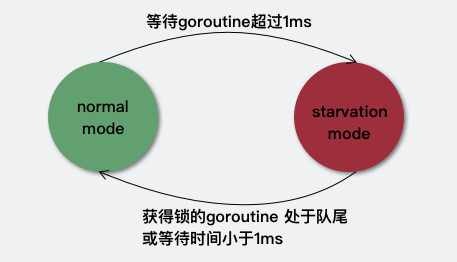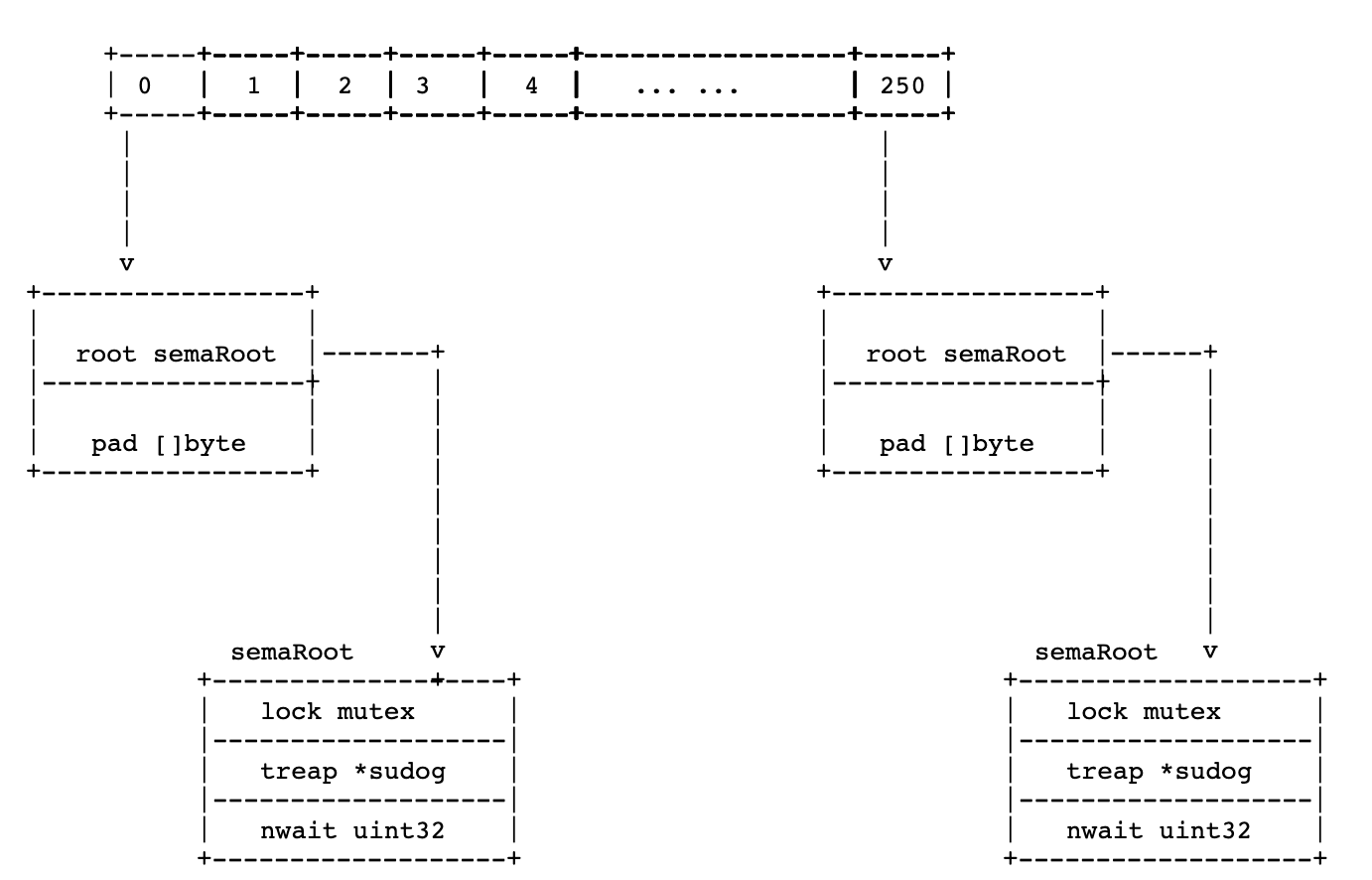Mutex是一个互斥的排他锁,零值Mutex为未上锁状态,Mutex一旦被使用 禁止被拷贝。使用起来也比较简单
package main
import "sync"
func main() { m := sync.Mutex{} m.Lock() defer m.Unlock() // do something}
复制代码
Mutex有两种操作模式:
阻塞等待的goroutine保存在FIFO的队列中,唤醒的goroutine不直接拥有锁,需要与新来的goroutine竞争获取锁。因为新来的goroutine很多已经占有了CPU,所以唤醒的goroutine在竞争中很容易输;但如果一个goroutine获取锁失败超过1ms,则会将Mutex切换为饥饿模式。
这种模式下,直接将等待队列队头goroutine解锁goroutine;新来的gorountine也不会尝试获得锁,而是直接插入到等待队列队尾。
如果一个goroutine获得了锁,并且他在等待队列队尾 或者 他等待小于1ms,则会将Mutex的模式切换回正常模式。正常模式有更好的性能,新来的goroutine通过几次竞争可以直接获取到锁,尽管当前仍有等待的goroutine。而饥饿模式则是对正常模式的补充,防止等待队列中的goroutine永远没有机会获取锁。
其数据结构为:
type Mutex struct { state int32 // 锁竞争的状态值 sema uint32 // 信号量}
复制代码
state 代表了当前锁的状态、 是否是存在自旋、是否是饥饿模式、阻塞goroutine数量
mutexLocked = 1 << iota // mutex is locked mutexWoken mutexStarving mutexWaiterShift = iota
复制代码
mutex.state & mutexLocked 加锁状态 1 表示已加锁 0 表示未枷锁
mutex.state & mutexWoken 唤醒状态 1 表示已唤醒状态 0 表示未唤醒
mutex.state & mutexStarving 饥饿状态 1 表示饥饿状体 0 表示正常状态
mutex.state >> mutexWaiterShift得到当前 goroutine 数目
Lock
上锁大致分为fast-path和slow-path
Fast-path
lock 通过调用atomic.CompareAndSwapInt32来竞争更新m.state,成功则获得锁;失败,则进入slow-path
func (m *Mutex) Lock() { // Fast path: grab unlocked mutex. if atomic.CompareAndSwapInt32(&m.state, 0, mutexLocked) { if race.Enabled { race.Acquire(unsafe.Pointer(m)) } return } // Slow path (outlined so that the fast path can be inlined) m.lockSlow()}
复制代码
atomic.CompareAndSwapInt32正如签名一样,进行比较和*交换*操作,这过程是原子的
// CompareAndSwapInt32 executes the compare-and-swap operation for an int32 value.func CompareAndSwapInt32(addr *int32, old, new int32) (swapped bool)
复制代码
源码中我们并不能看到该函数的具体实现,他的实现跟硬件平台有关,我们可以查看汇编代码一窥究竟,go tool compile -S mutex.go也可以对二进制文件go tool objdump -s methodname binary
0x0036 00054 (loop.go:6) MOVQ AX, CX 0x0039 00057 ($GOROOT/src/sync/mutex.go:74) XORL AX, AX 0x003b 00059 ($GOROOT/src/sync/mutex.go:74) MOVL $1, DX 0x0040 00064 ($GOROOT/src/sync/mutex.go:74) LOCK 0x0041 00065 ($GOROOT/src/sync/mutex.go:74) CMPXCHGL DX, (CX) 0x0044 00068 ($GOROOT/src/sync/mutex.go:74) SETEQ AL 0x0047 00071 ($GOROOT/src/sync/mutex.go:74) TESTB AL, AL 0x0049 00073 ($GOROOT/src/sync/mutex.go:74) JEQ 150 0x004b 00075 (loop.go:8) MOVL $8, ""..autotmp_6+16(SP) 0x0053 00083 (loop.go:8) LEAQ sync.(*Mutex).Unlock·f(SB), AX
复制代码
重点关注第 5 行CMPXCHGL DX, (CX)这个CMPXCHGL是 x86 和 Intel 架构中的compare and exchange指令,Java的那套AtomicXX底层也是依赖这个指令来保证原子性操作的。
所以我们看到Mutex是互斥排他锁且不可重入,当我们在一个goroutine获取同一个锁会导致死锁。
package main
import "sync"
func main() { m := sync.Mutex{} m.Lock() //这里会导致死锁 m.Lock() defer m.Unlock()}
复制代码
slow-path
如果goroutinefast-path 失败,这调用m.lockSlow()进入slow-path,函数内部主要是一个for{}死循环,进入循环的goroutine大致分为两类:
新来的gorountine
被唤醒的goroutine
Mutex默认为正常模式,若新来的goroutine抢占成功,则另一个就需要阻塞等待;阻塞等待一旦超过阈值 1ms 则会将Mutex切换到饥饿模式,这个模式下新来的goroutine只能阻塞等待在队列尾部,没有抢占的资格。当然等待阻塞->唤醒->参与抢占锁,这个过程显示不是很高效,所以这里有一个自旋的优化
当 mutex 处于正常模式且能够自旋,会让当前 goroutine 自旋等待,同时设置 mutex.state 的 mutexWoken 位为 1,保证自旋等待的 goroutine 一定比新来 goroutine 更有优先权。这样 unlock 操作也会优先保证自旋等待的 goroutine 获取锁
>
golang 对自旋做了些限制要求 需要:
>
- 多核 CPU
- GOMAXPROCS>1
- 至少有一个运行的 P 并且 local 的 P 队列为空
>
感兴趣的可以跟下源码比较简单
func (m *Mutex) lockSlow() { var waitStartTime int64 starving := false awoke := false iter := 0 old := m.state for { //饥饿模式下不能自旋,也没有资格抢占,锁是手递手给到等待的goroutine if old&(mutexLocked|mutexStarving) == mutexLocked && runtime_canSpin(iter) {//当Mutex处于正常模式且能够自旋 //设置mutexWoken为1 告诉unlock操作,存在自旋gorountine unlock后不需要唤醒其他goroutine if !awoke && old&mutexWoken == 0 && old>>mutexWaiterShift != 0 && atomic.CompareAndSwapInt32(&m.state, old, old|mutexWoken) { awoke = true } runtime_doSpin() iter++ old = m.state continue } // 自旋完了 还是没拿到锁 new := old //当mutex处于正常模式,将new的mutexLocked设置为1 即准备抢占锁 if old&mutexStarving == 0 { new |= mutexLocked } //加锁状态或饥饿模式下 新来的goroutine进入等待队列 if old&(mutexLocked|mutexStarving) != 0 { new += 1 << mutexWaiterShift }
//将Mutex切换为饥饿模式,若未加锁则不必切换 //Unlock操作希望饥饿模式存在等待者 if starving && old&mutexLocked != 0 { new |= mutexStarving } if awoke { // 当前goroutine自旋过 已被被唤醒,则需要将mutexWoken重置 if new&mutexWoken == 0 { throw("sync: inconsistent mutex state") } new &^= mutexWoken //重置mutexWoken } if atomic.CompareAndSwapInt32(&m.state, old, new) { // 当前goroutine获取锁前mutex处于未加锁 正常模式下 if old&(mutexLocked|mutexStarving) == 0 { break // 使用CAS成功抢占到锁 } // waitStartTime!=0表示当前goroutine是等待状态唤醒的 // 为了与第一次调用Lock的goroutine划分不同的优先级 queueLifo := waitStartTime != 0 if waitStartTime == 0 { //开始记录等待时间 waitStartTime = runtime_nanotime() } // 将被唤醒但是没有获得锁的goroutine插入到当前等待队列队首 // 使用信号量阻塞当前goroutine runtime_SemacquireMutex(&m.sema, queueLifo, 1) // 当goroutine等待时间超过starvationThresholdNs,mutex进入饥饿模式 starving = starving || runtime_nanotime()-waitStartTime > starvationThresholdNs old = m.state if old&mutexStarving != 0 { //如果当前goroutine被唤醒且mutex处于饥饿模式 则将锁手递手交给当前goroutine if old&(mutexLocked|mutexWoken) != 0 || old>>mutexWaiterShift == 0 { throw("sync: inconsistent mutex state") } //等待状态的goroutine - 1 delta := int32(mutexLocked - 1<<mutexWaiterShift) //如果等待时间小于1ms 或 当前goroutine是队列中最后一个 if !starving || old>>mutexWaiterShift == 1 { // 退出饥饿模式 delta -= mutexStarving } atomic.AddInt32(&m.state, delta) break } awoke = true iter = 0 } else { old = m.state } }}
复制代码
Unlock
解锁分两种情况
当前只有一个 goroutine 占有锁 unlock 完 直接结束
func (m *Mutex) Unlock() {
// 去除加锁状态 new := atomic.AddInt32(&m.state, -mutexLocked) if new != 0 {//存在等待的goroutine m.unlockSlow(new) }}
复制代码
unlock 完闭 mutex.state!=0 则存在以下可能
- 正常模式下
- 当前存在等待 goroutine 然后唤醒它 但不是第一个 goroutine
- 当前存在自旋等待的 goroutine 则不唤醒其他等待 gorotune
- 饥饿模式下
- 直接将锁交给等待队列的第一个 goroutine
func (m *Mutex) unlockSlow(new int32) { //未加锁的情况下不能多次调用unlock if (new+mutexLocked)&mutexLocked == 0 { throw("sync: unlock of unlocked mutex") } if new&mutexStarving == 0 {//正常模式下 old := new for { //没有等待的goroutine 或 已经存在一个获得锁 或被唤醒 或处于饥饿模式下不需要唤醒任何处于等待的goroutine if old>>mutexWaiterShift == 0 || old&(mutexLocked|mutexWoken|mutexStarving) != 0 { return } // 等待状态goroutine数量-1 并设置唤醒状态为1 然后唤醒一个等待goroutine new = (old - 1<<mutexWaiterShift) | mutexWoken if atomic.CompareAndSwapInt32(&m.state, old, new) { //唤醒一个阻塞的goroutine 但不是第一个等待者 runtime_Semrelease(&m.sema, false, 1) return } old = m.state } } else { //饥饿模式下手递手将锁交给队列第一个等待的goroutine //即使期间有新来的goroutine到来,只要处于饥饿模式 锁就不会被新来的goroutine抢占 runtime_Semrelease(&m.sema, true, 1) }}
复制代码
信号量
上面可以看到Mutex对goroutine的阻塞和唤醒操作是利用semaphore来实现的,大致的思路是:Go runtime 维护了一个全局的变量semtable,它保持了所有的信号量
// Prime to not correlate with any user patterns.const semTabSize = 251
var semtable [semTabSize]struct { root semaRoot pad [cpu.CacheLinePadSize - unsafe.Sizeof(semaRoot{})]byte}
复制代码
每个信号量都由一个变量地址指定,Mutex 的栗子里就是mutex.sema的地址
type semaRoot struct { lock mutex treap *sudog // root of balanced tree of unique waiters. nwait uint32 // Number of waiters. Read w/o the lock.}
复制代码
大致画了下其数据结构
当goroutine未获取到锁,需要阻塞时调用sync.runtime_SemacquireMutex 进入阻塞逻辑
//go:linkname sync_runtime_SemacquireMutex sync.runtime_SemacquireMutexfunc sync_runtime_SemacquireMutex(addr *uint32, lifo bool, skipframes int) { semacquire1(addr, lifo, semaBlockProfile|semaMutexProfile, skipframes)}
func semacquire1(addr *uint32, lifo bool, profile semaProfileFlags, skipframes int) { gp := getg() if gp != gp.m.curg { throw("semacquire not on the G stack") }
// 低成本case // 若addr大于1 并通过CAS -1 成功,则获取信号量成功 不需要阻塞 if cansemacquire(addr) { return }
// 复杂 case: // 增加等待goroutine数量 // 再次尝试cansemacquire 成功则返回 // 失败则将自己作为一个waiter入队 // sleep // (waiter descriptor is dequeued by signaler) s := acquireSudog() root := semroot(addr) t0 := int64(0) s.releasetime = 0 s.acquiretime = 0 s.ticket = 0 if profile&semaBlockProfile != 0 && blockprofilerate > 0 { t0 = cputicks() s.releasetime = -1 } if profile&semaMutexProfile != 0 && mutexprofilerate > 0 { if t0 == 0 { t0 = cputicks() } s.acquiretime = t0 } for { lock(&root.lock) // 给nwait+1 这样semrelease中不会进低成本路径了 atomic.Xadd(&root.nwait, 1) // 检查 cansemacquire 避免错过唤醒 if cansemacquire(addr) { atomic.Xadd(&root.nwait, -1) unlock(&root.lock) break } //cansemacquire之后的semrelease都可以知道我们正在等待 //上面设置了nwait,所以会直接进入sleep 即goparkunlock root.queue(addr, s, lifo) goparkunlock(&root.lock, waitReasonSemacquire, traceEvGoBlockSync, 4+skipframes) if s.ticket != 0 || cansemacquire(addr) { break } } if s.releasetime > 0 { blockevent(s.releasetime-t0, 3+skipframes) } releaseSudog(s)}
复制代码
如果 addr 大于 1 并通过 CAS-1 成功则获取信号量成功,直接返回
否则通过对信号量地址偏移取模&semtable[(uintptr(unsafe.Pointer(addr))>>3)%semTabSize].root拿到semaRoot(这里个 3 和 251 没有明白为什么时这两个数???),semaRoot包含了一个sudog链表和一个nwait整型字段。nwait表示该信号量上阻塞等待的 g 的数量,同时为了保证线程安全需要一个互斥量来保护链表。
这里需要注意的是 此处的 runtime.mutex 并不是之前所说的 sync.Mutex,是内部的一个简单版本
简单来说,sync_runtime_Semacquire就是 wait 知道*s>0 然后原子的递减它,来完成同步过程中简单的睡眠原语
当goroutine要释放锁 唤醒等待的 g 时调用sync.runtime_Semrelease
//go:linkname sync_runtime_Semrelease sync.runtime_Semreleasefunc sync_runtime_Semrelease(addr *uint32, handoff bool, skipframes int) { semrelease1(addr, handoff, skipframes)}
func semrelease1(addr *uint32, handoff bool, skipframes int) { root := semroot(addr) atomic.Xadd(addr, 1)
// Easy case: no waiters? // 这个检查必须发生在xadd之后 避免错过唤醒 // (see loop in semacquire). if atomic.Load(&root.nwait) == 0 { return }
// Harder case: 搜索一个waiter 并唤醒它 lock(&root.lock) if atomic.Load(&root.nwait) == 0 { // count值已经被另一个goroutine消费了 // 所以不需要唤醒其他goroutine unlock(&root.lock) return } s, t0 := root.dequeue(addr) if s != nil { atomic.Xadd(&root.nwait, -1) } unlock(&root.lock) if s != nil { // May be slow, so unlock first acquiretime := s.acquiretime if acquiretime != 0 { mutexevent(t0-acquiretime, 3+skipframes) } if s.ticket != 0 { throw("corrupted semaphore ticket") } if handoff && cansemacquire(addr) { s.ticket = 1 } readyWithTime(s, 5+skipframes) }}
复制代码
关于信号量更深层的研究可以看下semaphore in plan9
总结
通过看源码发现个有意思的问题: 如果 goroutine g1 加的锁 可以被另一个 goroutine g2 解锁,但是等到 g1 解锁的时候就会 panic
















评论